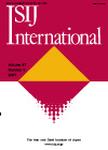版权所有:内蒙古大学图书馆 技术提供:维普资讯• 智图
内蒙古自治区呼和浩特市赛罕区大学西街235号 邮编: 010021

作者机构:Faculty of Materials and Manufacturing Beijing University of Technology 100 Pingleyuan Chaoyang District Beijing100124 China School of Metallurgical and Ecological Engineering University of Science and Technology Beijing 30 Xueyuan Rd. Haidian Dist. Beijing100083 China The Key Laboratory of Advanced Functional Materials Faculty of Materials and Manufacturing Beijing University of Technology 100 Pingleyuan Chaoyang District Beijing100124 China School of Mechanical and Materials Engineering North China University of Technology 5 Jinyuanzhuang Rd. Shijingshan Dist. Beijing100144 China
出 版 物:《ISIJ International》 (ISIJ Int)
年 卷 期:2024年第64卷第14期
页 面:2020-2030页
核心收录:
学科分类:080602[工学-钢铁冶金] 0806[工学-冶金工程] 08[工学]
基 金:The authors are grateful for support from the National Key R&D Program (No. 2023YFB3709900) the National Natural Science Foundation of China (Grant No. U22A20171) and the High Steel Center (HSC) at the North China University of Technology and University of Science and Technology Beijing China
主 题:Manganese
摘 要:The effect of the cooling rate on the morphology, number density, and size distribution of MnS inclusions in a high sulfur steel was investigated. With the increase of the cooling rate from 15 K/min to 300 K/min, the number density of MnS inclusions ranged from 91 #/mm2 to 192 #/mm2, and the average size of MnS inclusions decreased from 7.4 μm to 5.3 μm. A coupled model was developed to predict the precipitation and growth of MnS inclusions. The precipitation temperature of MnS at different cooling rates was approximately 1 823 K, which agreed well with experimental results. Through the high-temperature confocal scanning laser microscope, the precipitation process of MnS in a high sulfur steel during the solidification was observed. Inclusions of MnS primarily precipitated at grain boundaries, while the morphology of MnS before and after solidification was influenced by the cooling rate. A higher cooling rate promoted elongated MnS inclusions precipitated, and smaller MnS inclusions were precipitated after solidification. Conversely, a slower cooling rate led to the massive MnS inclusions precipitated during solidification, leading to the formation of elongated MnS particles. © 2024 The Iron and Steel Institute of Japan.